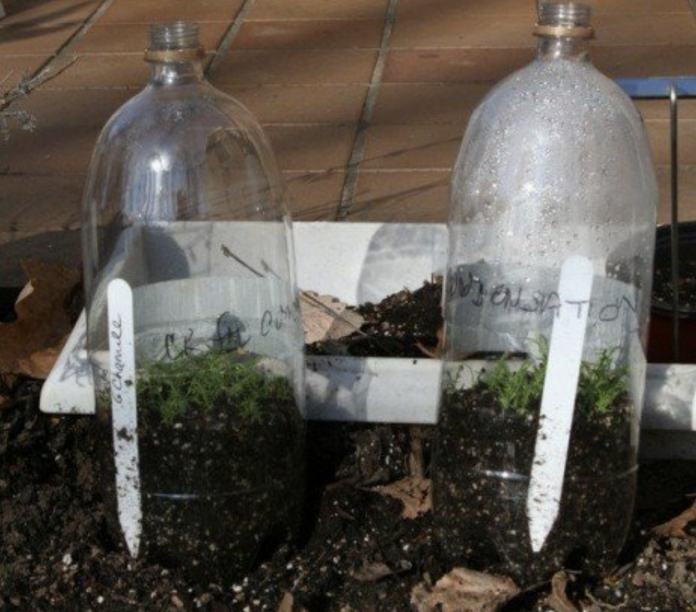If you don’t have the space or lighting to start seedlings indoors, winter sowing might be the best way to get a head start on your spring gardening. Using recycled containers, you can create miniature greenhouses to sow the seeds of plants that would normally survive winter as perennials or reseeding annuals and start seedlings outdoors.
Winter sowing is simple and convenient. Inside plastic bottles or milk jugs seeds are protected despite the weather and temperature outdoors. Additionally, seeds can be sown any time after the first day of winter as long as nights are still cold. Successful winter sowing is dependent on selecting the right seeds for your planting zone and ensuring good drainage and adequate air transpiration.
Selecting seeds
You can determine which seeds are suitable for winter sowing by referring to germination requirements. Seeds that will work will have directions that contain terms like pre-chilling, freeze, refrigerate, stratify, colonize and self-sows. Other phrases that may indicate a seed is suited to winter planting include “sow outdoors in early spring or while frosts may still occur,” “sow early autumn,” “hardy,” “withstands frost” and “direct sow early.” Additionally, “wildflower” or “weed” in the plant name is a good indicator that variety can withstand winter sowing.
You may also refer to seeds natural growing environment. Seeds with common names indicating a natural environment — plains, mountain, field, river — or an origin in a temperate climate such as Siberian, Orientale, Canadensis can be sown outdoors during winter.
Choosing containers
Containers used for winter sowing have two important requirements. First, if you choose a tinted container, your hand must be visible through the plastic to ensure enough light is getting through. Second, your container has to be deep enough to allow 3-4 inches of potting soil, plus headroom for growing seedlings.
Examples of containers that work well:
- Plastic milk jugs
- Water jugs
- 2-liter soda bottles
- Deep foil pans with clear domed lids
- Quart dairy containers
How to sow seeds outdoors during winter
- Prep containers. Remove and throw away caps from jugs and bottles as well as labels. Then wash containers in hot soapy water, rinse and allow time to dry.
- Convert containers into miniature greenhouses. Cut a horizontal slit half way up the side of your containers with a utility knife. Then use scissors to cut the container in half, leaving a 1-inch hinge. Next, use a pointed object to puncture 3/4-inch diameter holes in the bottom of each container to provide drainage.
- Label containers. Use lead-free, vinyl blind slats cut into 5-6″ lengths to write the seed’s name, the mature size and planting instructions on with a permanent marker.
- Add soil. Pre-moisten “soil-less” potting soil with warm water until it is slightly damp so it will wick up the water. Then fill your containers at least 3-4 inches deep. Next, tamp down the soil and add more if necessary. Avoid soil mixes that are prone to harden, states “weed-free”, contains fertilizer or water crystals.
- Plant seeds. Sprinkle seeds on top of the soil and gently press them down into the soil, ensuring there is good seed-to-soil contact. For seeds that require a depth of an inch or more, press them into the soil just below the surface, sprinkle soil over them to lightly cover and gently press down. Place the labels you made in step three inside the container along the side so that they are visible.
- Ensure air transpiration. If you chose a container with a lid, poke 4 to 5 1/4-inch holes in the lid to provide air transpiration.
- Ensure light. If you chose a container with a lid that’s not clear, remove the lid and use clear plastic to cover the top of the container. You can secure the plastic with clear plastic tape. You’ll also have to poke 4 to 5 1/4-inch holes in the plastic.
- Water your greenhouse. Set your containers in several inches of water overnight to soak up moisture.
- Choose a location for your containers. Put your containers in a protected area such as a deck, uncovered porch, against a fence or in a flowerbed. Sunny areas work best, so that the air inside the container warms up to create condensation.
- Watch for condensation. When you can see condensation inside your containers it means there’s enough moisture for your seeds to grow. If you don’t notice condensation on a sunny day above 32 F, water the seeds by dripping water slowly down the sides of the container or setting the containers in water. If there’s still no visible condensation inside your containers, it means your ventilation holes are too big and you may need to tape over some of them.
- Ensure drainage. If you notice your containers are holding too much water, the holes in the bottom may be too small. Try to enlarging the holes to improve drainage.
- Adjust your containers as your seeds grow. When temperatures rise and your seeds begin to grow make slits in the tops of your containers. As they continue to grow widen the slits until there are more open areas than covered areas and you can transplant them into your garden.












